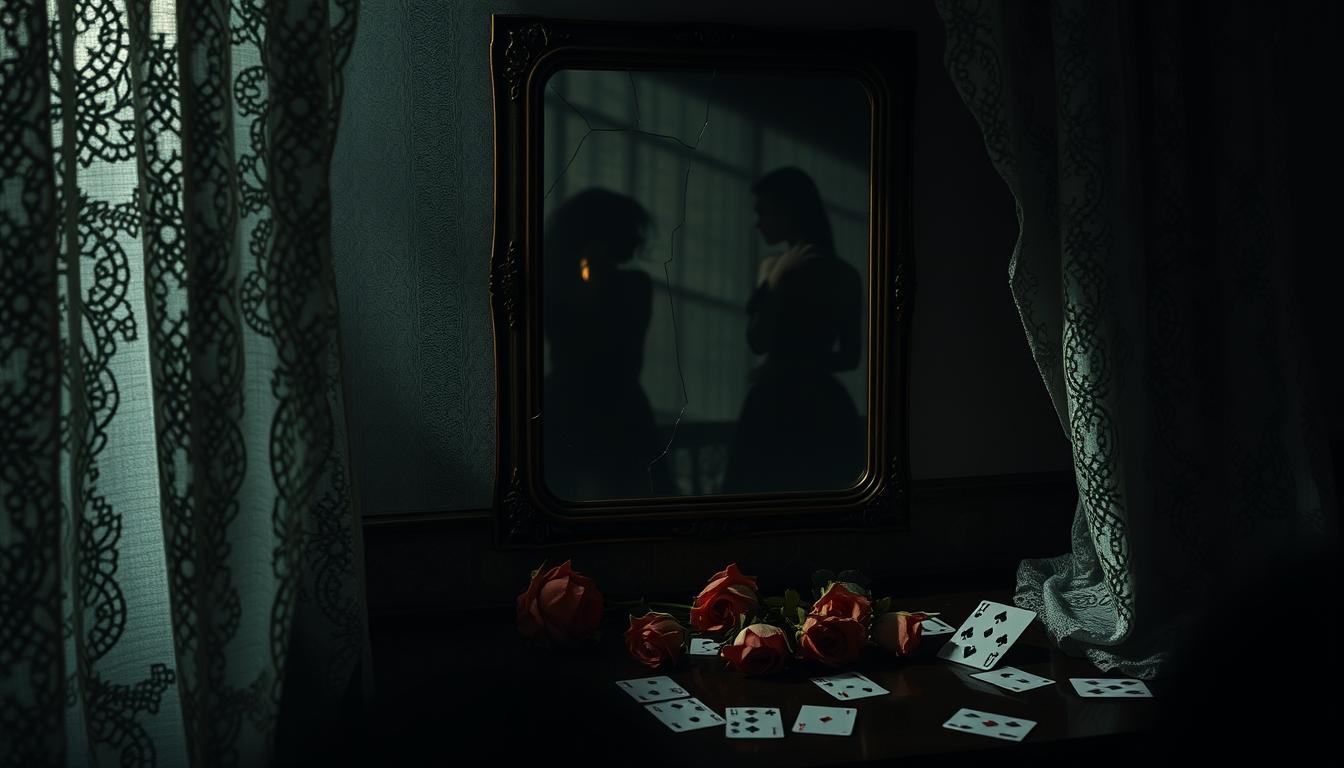Explore the world of psychological thrillers and dark romance. These stories show complex relationships, where trust and betrayal are key. They pull readers into a world of deep emotions and dangerous paths.
Emotional manipulation is a big part of these stories. Authors use it to keep readers excited. As characters trust and betray each other, readers feel the ups and downs right along with them.
Dark romance digs deep into human nature. It shows how trust can protect and harm. These stories reveal the true nature of love and fear, mixing them in surprising ways.
The Allure of Psychological Dark Romance
Psychological dark romance draws readers in with its look into forbidden love and strong feelings. It dives deep into human psychology, offering a thrilling break from daily life. Its charm comes from pushing limits and questioning what’s normal.
At its core, these stories are about complex minds. Characters face inner struggles, past hurts, and mixed desires. This makes them feel real and easy to connect with.
Readers get swept up in the characters’ battles, feeling every emotion with them.
The genre’s charm also comes from tackling forbidden topics. It bravely explores dark areas, discussing things often left unsaid. This boldness adds excitement and danger, keeping readers hooked.
Reader engagement is a big reason for its popularity. The detailed plots and complex relationships make readers think and guess. They become deeply involved, eagerly waiting for each new turn. This makes reading a truly immersive experience that stays with you.
Defining Trust and Betrayal in Literature
In books, trust and betrayal shape how characters relate to each other. They drive the emotional stories. These elements are key in dark romance, making the character interactions intense.
The Psychological Impact of Trust
Trust is the base of deep connections in stories. Characters who trust others show their true selves. This creates bonds that grab readers’ attention.
This openness leads to close moments and shared stories. It makes the plot and characters grow.
The Devastating Effects of Betrayal
Betrayal is a strong plot tool, breaking trust and causing deep hurt. When characters face betrayal, it sparks strong feelings. It often leads to big changes in them.
The hurt from betrayal can last a long time. It affects future relationships and choices.
The Interplay Between Trust and Betrayal
The mix of trust and betrayal makes for great stories. Characters must choose to trust again after being betrayed. This choice adds to their stories and keeps readers hooked.
The push and pull between trust and fear of betrayal is at the heart of many dark romances.
The Origins of Dark Romance in Literature
Dark romance started with Gothic literature in the late 18th century. Novels like “Frankenstein” by Mary Shelley and “Dracula” by Bram Stoker began exploring love, fear, and the supernatural. These stories drew readers in with their spooky settings and deep characters.
The Romantic movement of the 19th century also influenced dark romance. Writers like Edgar Allan Poe and Emily Brontë mixed intense emotions with darker themes. Poe’s “The Fall of the House of Usher” and Brontë’s “Wuthering Heights” show how love can be both beautiful and destructive.
Over time, dark romance evolved. The 20th century saw a new twist with psychological thrillers. Authors like Daphne du Maurier and Patricia Highsmith dug into characters’ minds. They explored trust, betrayal, and desire, making modern dark romance even more intense.
Psychological Manipulation in Dark Romance Narratives
Dark romance stories dive deep into toxic relationships. They create complex webs of psychological warfare. This draws readers into a world where love and pain mix together.
The characters use manipulative tactics. They blur the lines between love and control.
Gaslighting and Emotional Abuse
In these stories, gaslighting is a powerful tool. Characters twist reality, making their partners question their own thoughts. This emotional abuse makes readers feel uneasy.
It shows the psychological impact on the victims.
Power Dynamics and Control
Dark romance often focuses on power struggles. One character may control through wealth, status, or strength. These imbalances create tension.
It makes for a thrilling dance of power and submission.
The Fine Line Between Love and Obsession
As the story goes on, love turns into obsession. Characters cross lines, driven by a strong need to own their partner. This adds depth to the story.
It makes readers question what love and relationships really are.
Trust and Betrayal: Core Themes in Psychological Dark Romance Stories
Trust and betrayal are at the core of psychological dark romance stories. These themes create a lot of tension. They keep readers guessing and on edge.
In these stories, trust and betrayal are key. Characters often have trouble trusting because of past traumas. This makes their journey more intense and emotional.
Plot twists in dark romance often come from betrayals. A trusted friend might have a secret. This can change everything for the main character.
The mix of trust and betrayal makes readers feel all sorts of emotions. Characters’ trust is tested, adding suspense. This keeps readers wanting to know what happens next.
The Role of Trauma in Shaping Characters
Trauma is key in making characters in dark romance stories. Their backstory shows deep wounds that shape their actions and relationships. These scars make their personalities complex, driving the story and creating interesting arcs.
Authors build detailed histories for their characters. They mix past experiences with today’s struggles. A character’s past trauma might lead to trust issues, fear of closeness, or self-harm.
How characters cope with trauma is a big theme. They might find healthy ways or harmful ones. Some find comfort in art or sports, while others turn to addiction or dangerous acts.
Looking at trauma in dark romance shows how strong and weak we are. By exploring characters’ scars, authors let them grow, heal, and find redemption. This makes the story richer and gives readers a peek into human psychology and relationships.
Exploring the Gray Areas of Morality
Dark romance stories are all about complex characters. They make us question what’s right and wrong. These stories take us into a world where good and evil aren’t clear-cut.
Antihero Protagonists
Antiheroes are fascinating because they’re not perfect. They make choices that might not be right, but we still feel for them. Their struggles and growth keep us hooked, even when we don’t agree with them.
Sympathetic Villains
Dark romance flips the script on traditional villains. By showing their pasts and reasons, authors make us feel for them. We’re caught between hating their actions and understanding their pain. This makes the story even more emotional.
Moral Ambiguity in Relationships
The core of dark romance is in its complex relationships. Characters deal with love, loyalty, and betrayal. These situations make us think about our own moral views.
Dark romance shows us the depth of human experience. It makes us see beyond simple labels. This genre’s strength is in making us question our morals while loving deeply flawed characters.
The Psychology of Redemption Arcs
Redemption arcs are key in dark romance stories. They show how characters grow by facing past mistakes. They seek forgiveness and heal from within.

In dark romance, characters often start broken. They feel guilty, ashamed, and face the consequences of their actions. The journey to redemption involves owning up to mistakes. This journey leads to deep personal change.
Forgiveness is crucial in redemption arcs. Characters must forgive themselves and others. This forgiveness helps them heal and rebuild trust. Through facing past traumas, they learn more about themselves and others.
The path to redemption is not easy. Characters meet many challenges and setbacks. They must face their fears and change old habits. This struggle makes the story emotionally engaging for readers.
Redemption arcs in dark romance offer hope and change. They show that even flawed characters can heal and grow. These stories inspire by proving transformation is possible, even from a dark start.
Trust-Building Techniques in Dark Romance Plots
Dark romance authors use special techniques to make characters’ relationships deeper. These methods take readers on a journey of emotional connection. Let’s look at what makes these stories so captivating.
Vulnerable Moments and Shared Secrets
Characters in dark romance show their weak sides, which brings them closer. Sharing secrets is a big part of building trust. These moments let readers feel the characters’ fears and dreams.
Acts of Sacrifice and Protection
Trust grows when characters put themselves in danger to protect others. These acts show their commitment. Readers see how characters change from looking out for themselves to truly caring for others.
Gradual Emotional Intimacy
Dark romance stories focus on building emotional connections slowly. Authors create scenes that show how characters grow closer. This slow pace makes the relationship feel real and deep.
Betrayal as a Plot Device: Types and Impacts
Betrayal is a strong tool in dark romance stories. It drives twists in the story and shapes characters. Writers use different kinds of betrayal to add tension and move the plot along.
Common types include cheating, broken promises, and unexpected changes in loyalty. These betrayals lead to big confrontations and emotional scenes. They keep readers excited and guessing.
The effects of betrayal on characters are deep and lasting. It can break trust, cause anger or sadness, and make characters question their relationships. Sometimes, betrayal changes a character’s whole personality or goals.
Good authors use betrayal to surprise readers with plot twists. They plan out characters’ motivations and pasts to make betrayals seem both shocking and right. The emotional scenes that follow let readers feel close to the characters. This is why dark romance novels are so popular.
The Reader’s Emotional Journey in Dark Romance
Dark romance novels offer a unique reading experience. They take readers on an emotional rollercoaster. This journey creates deep connections with characters and plot twists.
The stories have a profound psychological impact. They leave lasting impressions on readers.
Empathy and Character Attachment
Readers often bond strongly with dark romance characters. Complex personalities and flawed protagonists make it easy to relate and empathize. This emotional connection drives readers to support characters, even when they make questionable choices.
Tension and Anticipation
Dark romance stories are great at building tension. Unpredictable plot twists and morally ambiguous situations keep readers on edge. This creates an addictive reading experience, making readers want to keep turning pages.
Catharsis and Emotional Release
The intense emotions in dark romance often lead to catharsis. As conflicts resolve and characters overcome obstacles, readers feel relief and emotional release. This journey can be both exhausting and exhilarating, leaving readers deeply satisfied.
The power of dark romance lies in its ability to evoke strong emotions. By taking readers on this intense emotional journey, these stories create memorable experiences. These experiences resonate long after the final page is turned.
Symbolic Representations of Trust and Betrayal
Dark romance stories often use symbols to explore trust and betrayal. Authors add depth to these complex emotions with metaphorical elements. Symbols can carry deep meanings without needing to say it out loud.

Locks and keys often symbolize trust. When a character gives their key, it means they’re opening up. But a broken lock can show betrayal or a broken trust.
Weather also plays a big role. Storms can mean a rough relationship, while clear skies show trust and stability.
Colors have their own meanings too. Red might mean passion or danger, while black could mean secrets or hidden plans. Authors might use the same objects to show trust or hint at betrayal. A gift early in the story might later remind us of broken promises.
These symbols create a rich meaning in stories. They help readers feel the emotions of trust and betrayal with the characters. By using these techniques, authors can make stories that stay with us long after we finish reading.
Cultural Influences on Trust and Betrayal Themes
Trust and betrayal themes in dark romance stories show our world’s cultural diversity. These stories come from a wide range of global literature. They give us unique views on what society expects in different cultures.
Western vs. Eastern Perspectives
Western dark romance often talks about personal desires and freedom. Eastern stories usually highlight family honor and group harmony. This difference affects how characters deal with trust and betrayal in their relationships.
Historical Context and Social Norms
Historical settings are key in shaping trust. Victorian-era romances show the struggle between strict rules and forbidden love. Today’s stories explore trust in our digital world.
Contemporary Interpretations
Modern dark romance authors mix cultural influences for exciting stories. They question old norms and offer fresh views on trust and betrayal. This mix shows our world’s growing connection and changing relationships.
Dark romance stories with diverse cultures help us understand human connections better. They entertain and teach us to value the rich global literature out there.
The Impact of Point of View on Trust Perception
In dark romance stories, how we see trust and betrayal changes a lot. First-person stories make us feel close to the main character. This makes us trust them more because we see things from their point of view.
Third-person stories give us a wider view. We see what different characters think and feel. This helps us understand trust issues better and see betrayal from many sides.
Unreliable narrators make things even more interesting. They make us doubt what we’re reading. This feeling of doubt mirrors the trust problems in dark romance stories. As we read, we keep guessing and learning, which makes the story more thrilling.
Authors pick the story’s point of view to change how we see trust and betrayal. This choice makes characters more real and keeps us guessing. It turns us into detectives, trying to figure out the truth in the story.



